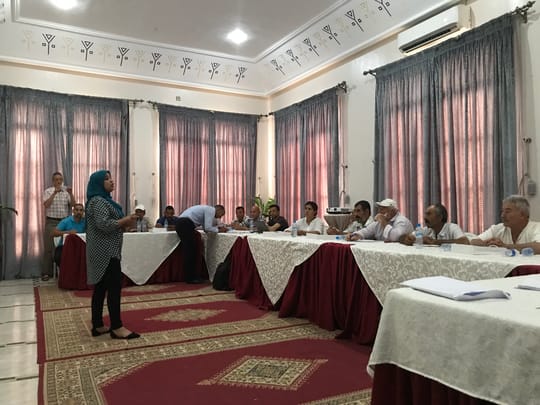Georgina Kenchington
HAF Volunteer

Quote of the day: mother nature is most definitely in charge here. Approximately 270 kilometers, or 3.5 hours drive from Oujda lies Bouarfa, the destination of my first experience with cooperatives as a volunteer with the High Atlas Foundation. More specifically, the Farmer-to-Farmer USAID Project, which aims to harness the potential of these cooperatives and, through capacity-building and participatory methods, empower their members and strengthen their economic prospects. But, before I get to that, I’m going to begin a little bit atypically – with the story of how the day ended.

Oujda and Bouarfa are connected by a single roadway, slicing through seemingly endless stretches of desert landscape for a majority of the drive. On a typical day, the existence of a lone road doesn’t pose a problem. Bouarfa isn’t a city brimming with tourists or outsiders, and probably doesn’t appear on most top Google search hits for sentences synonymous with “destinations one must visit while in Morocco;” the road is quiet, quick, and functional for a city primarily made up of local farmers. So, at the end of our day, I hopped back in the car with no inklings of anything about to go amiss.

Fast forward 30 minutes and the desert highway is no longer a desert highway. Instead, it’s almost as if mother nature decided to take revenge on the road for slicing the desert in two, and in retaliation sent a rainwater river to render the route impassable. Needless to say, we were entirely stuck, and now part of a small group of fellow travelers with little else to do than laugh at the futility of the situation, take a few pictures, and enjoy the rainbow forming across the skyline to our right (mother nature signing her work?). But, standing there, awaiting a decision on whether or not we would be able to continue without the car suddenly transforming into an amphibious vehicle, the reasoning behind Bouarfa as a destination and focal point for HAF’s work that day became all the more clear to me.

Earlier in the afternoon, we’d arrived in Bouarfa for a participatory meeting of local cooperatives, with representatives from 20 different cooperatives in attendance. The meeting presented a unique opportunity: a single forum for members of a vast array of local groups to voice the challenges they face when it comes to output maximization and sustainable agricultural practices. Broadly speaking, conversation centered around three common problems in the region: 1) a lack of proper technical expertise in the realm of irrigation, 2) insects interfering with the quality of produce, and 3) the impacts of unpredictable weather patterns on agricultural cycles. Like I said, mother nature is most definitely in charge here. But remember, just because she’s in charge doesn’t mean that, if we build the proper foundations and relationships, we can’t find a way to work together and with her to achieve greater economic security.

Today, I saw one of these relationships in action, when women from Moughle Cooperative instantly recognized a member of the HAF team who had led an IMAGINE workshop with participation from their cooperative nearly a year ago. One year later, she and other members of the cooperative precisely and fondly recalled even the smallest details of the workshop, including the music choices, and over tea and dates later in the day, reflected on the positive impact the experience has had. For these women, the long-term benefits of are only at their beginning stages, and yet already include stronger self-awareness, a greater sense of commitment to their cooperative, and an impressive variety of marketably packaged products to show for it.

For cities like Bouarfa, unfrequented by outsiders, and accessible by a single road subject to the whims of nature, the path forward lies in such needs-based assessments and the work of organizations like HAF to build positive relationships with cooperatives and with the surrounding environment. While today only gave me a broad introduction to the region and the work that can be done, I’m excited to see what lies ahead (road rivers and all).
Give to this project.
